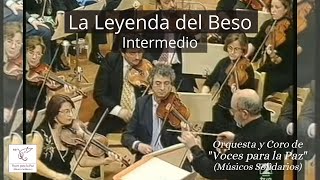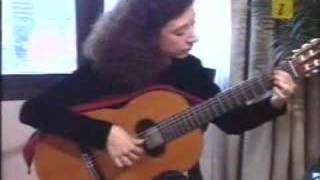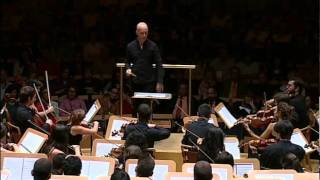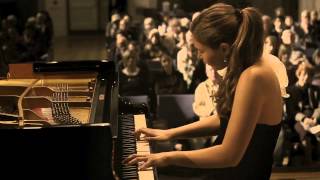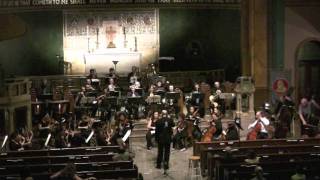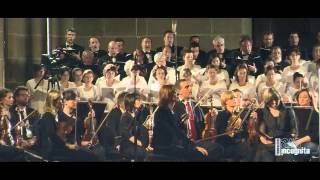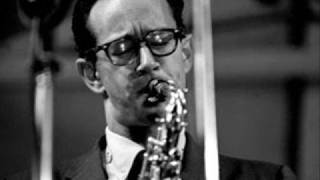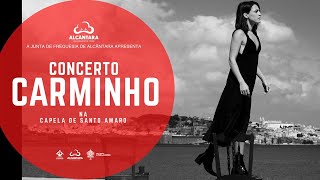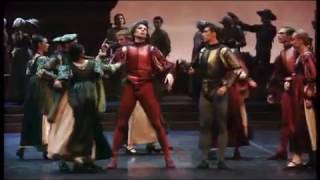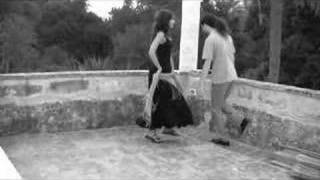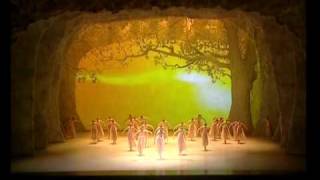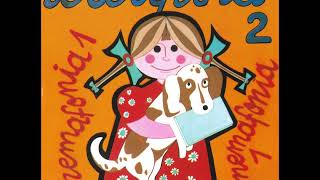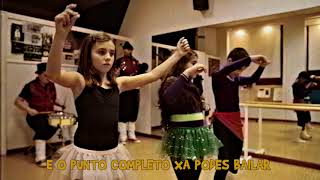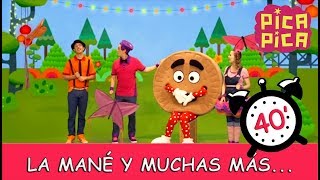On September 22nd at 8:19 p.m., peninsular time, Autumn begins.
Recommended music videos for initiation to classical music
Antonio Vivaldi (1678-1741) was an Italian priest, violinist, and composer known as the Red Priest ("il prete rosso"). He was born in Venice and learned to play the violin with his father as a child. At the age of 15, he entered the Seminary and once ordained a priest, he could barely attend to his religious obligations due to his health problems. So he was appointed violin teacher at an orphanage where he taught theory and instrumental classes. At the age of 40, he was appointed Chapel Master in Mantua , where he wrote his famous Four Seasons . From there he moved to Milan , then to Rome ; later, again to Venice , and finally to Vienna , where he died. Throughout his life, he composed almost 800 works, half of which were concertos, 40 operas, 60 religious works, and numerous sonatas.
The Four Seasons , Vivaldi 's best-known work, is a set of four concertos for violin and orchestra (each concerto is dedicated to a season: Spring, Summer, Autumn, and Winter ). Unusually for the time, Vivaldi published the concertos with accompanying poems describing what he intended to depict in relation to each of the seasons. The work provides one of the earliest and most detailed examples of what would later be called program or descriptive music —music with a narrative element.
Autumn : I (0´5´´) ALLEGRO “The rustic celebrates with dances and songs the happy grape harvest and the joyful pleasure of Bacchus ’ liquor; he abuses it so much that his joy ends in sleep”.-. II (4´45´´) ADAGIO MOLTO. “Everyone should dance and sing. The mild air gives pleasure and well-being, and the season invites many to the beautiful joy of a sweetest dream”.-. III (7´14´´) ALLEGRO. “At dawn the hunter goes out to hunt with horns, shotguns and dogs. The beast flees, and they track it. Already surprised and exhausted by the great noise of shotguns and dogs; wounded, tired of fleeing and defeated, overwhelmed it dies” (Says Vivaldi).
Today it is offered to us by Julia Fischer as a soloist, accompanied by the Academy of St Martin in the Fields .
Reveriano Soutullo Otero ( Puenteareas , Pontevedra, July 11, 1880 - Madrid , October 29, 1932) was a Spanish composer of zarzuelas and pasodobles. His father directed the Redondela band, so Reveriano was close to music from a young age. At 19, he went to study at the Madrid Conservatory and in the meantime, he earned a living playing the cornet. He suffered an ear infection that left him half deaf. In Madrid he studied harmony and composition for three years, a subject in which he received the extraordinary prize. Between 1906 and 1907 he returned to Vigo , where he was awarded a scholarship to study music abroad. Thanks to this, he came into contact with Italian and German musicians; but the musicians who most influenced him were in Paris: Debussy and Ravel .
Juan Bautista Vert Carbonell ( Carcagente , Valencia, 1890 - Madrid , February 16, 1931) was a Spanish composer of zarzuelas. A few months after his birth, his family moved to Onteniente , the city where he grew up, lived and owned, beginning his musical studies with Enrique Casanova , director of the local band and organist of the Arciprestal Church of the Assumption of Santa María . A few years later, he continued his studies in piano, harmony and composition with Manuel Ferrando . At the age of fourteen he had already mastered the violin and piano and in 1911 he moved to Madrid, enrolling at the Royal Conservatory of Music , where he obtained the honor prize in Harmony and Composition . He died suddenly in his Madrid apartment at the age of forty while writing La Maja Serrana .
The Legend of the Kiss is a two-act zarzuela, divided into three scenes, with a libretto by Enrique Reoyo, José Silva Aramburu , and Antonio Paso , and music by Reveriano Soutullo and Juan Vert . It premiered to great acclaim at the Teatro Apolo in Madrid on Friday, January 18, 1924.
Today the Voices for Peace Orchestra , conducted by maestro Miguel Roa , offers us its famous Intermission , which was performed by the group Mocedades on the song Amor de hombre .
Carlos Vicente Guastavino (Santa Fe, April 5, 1912 - ibid., October 29, 2000) was an Argentine composer and pianist. He was born and died in Santa Fe , capital city of the Argentine province of the same name. His childhood was spent in a music-loving family; spontaneity and musical intuition were the first playful experiences of Carlos , the third of those six brothers, who at just four years of age, being a disciple of the pianist Esperanza Lothringer , debuted at the Teatro Municipal . Established in Buenos Aires , after a fleeting stay of a few months at the National Conservatory of Music , he continued his studies privately with the composer and pedagogue Athos Palma . With him, in an intensely brief period of time, he systematized his previous empirical knowledge, especially in the disciplines of harmony, morphology and counterpoint .
He led a life of travel and intense artistic experiences during the 1940s and 1950s. Travels through countries bordering Argentina , two stays in London , and a few months of touring the Soviet Union and China in 1956 cemented his reputation as a distinguished composer-pianist, specializing in his own chamber vocal and nationalist piano repertoire. His output is extensive in the field of chamber and solo repertoire: it includes vocal pieces for piano, a cappella choral works, and works for instrumental groups, piano, and guitar. Some were so widely distributed that they needed to be repeatedly reissued (the songs " Pueblito, mi pueblo ", " Se equivocó la paloma ", and " Bailecito " were and remain the most notable in this regard). Renowned classical and popular performers have featured his music in concerts and recordings throughout the 20th and 21st centuries.
Today, in a guitar version, we present Carlos Guastavino 's Bailecito performed by Silvia Costanzo .
Leonard Bernstein (1918 - 1990) was an American composer, pianist, and conductor. He was the first American -born conductor to achieve worldwide fame, famous for his performance of the New York Philharmonic Orchestra , for his Young People's Concerts broadcast on television between 1958 and 1972, and for his many compositions including West Side Story (1957) and Candide . He was also a pivotal figure in the modern revival of the music of Gustav Mahler , the composer who most interested him. As a composer, he wrote piano music, chamber music, choral music, religious music, numerous stage works for ballet, film, opera, and musicals, as well as an extensive orchestral body of work.
On the Town is a 1944 Broadway musical with music by Leonard Bernstein and lyrics by Betty Comden and Adolph Green, which features popular songs, including "New York, New York ." It was later adapted for film in 1945. The song " New York, New York" has become very popular in the United States and was included at number 41 on the American Film Institute 's 2004 list of the 100 most iconic songs in American cinema.
Today we offer the third movement of the Symphonic Suite from On the Town, Times Square , performed by the Symphony Orchestra of the Higher Conservatory of Music of Aragon conducted by maestro Juan Luis Martínez .
Recommended classical music videos
Wolfgang Amadeus Mozart (1756-1791) is considered one of the three giants of musical composition, along with Bach and Beethoven . A child prodigy born in Salzburg , Austria, he mastered the keyboard and violin at the age of six and began composing. His father, Leopold , exhibited him on exhausting tours of various European courts. A prolific composer (more than 600 works written between the age of five and his death), he cultivated all kinds of musical genres: piano works, chamber music, symphonies, concertante works, choral works, operas... each and every one of them a masterpiece of their kind. His operas The Magic Flute, Don Giovanni, Così fan Tutte, and The Marriage of Figaro are among the 10 most performed operas in the world. He died in Vienna at the age of 35.
The catalogue of Mozart's works or Köchel Catalogue ( Köchel Verzeichnis, in German) was created by Ludwig von Köchel in 1862 and lists the musical works composed by Wolfgang Amadeus Mozart . Each of Mozart 's works is designated by a number preceded by the abbreviation K. or KV ; this number designates the chronological order of its creation and which is actually valid for most of the works; however, in its first edition, works by other authors appear erroneously attributed to Mozart , and other authentic works that had not yet been discovered are omitted.
The Sonata was originally a composition of several sections (usually three or four) written to be played or "sounded" by one or more musical instruments, as the cantata was to be "sung" by one or more voices. From Classicism onwards (1750-1810) its definition was adjusted to a work generally structured in three movements (fast-slow-fast) and sometimes four, with or without a short introduction. It should not be confused with the sonata form , which is a compositional model consisting of three sections without interruption: a) exposition of the two main and contrasting themes, b) development of both themes, c) reexposition or recapitulation.
The Piano Sonata No. 11 in A major, K. 331 is the most famous of Mozart 's piano sonatas, particularly for its third movement , which has had countless transcriptions and versions and has been for many years one of the "workhorses" of pianists. Many musicologists (among them Saint Fiux ) maintain that this sonata is actually the tenth in the collection, while the preceding one in C major is the eleventh. However, Alfred Einstein remembers a letter dated June 9-12, 1784, addressed by Mozart to his father, in which he clearly indicates the three sonatas in C major, A major, and the next one in F major . The sonata consists of three movements: I (O'00") ANDANTE WITH VARIATIONS : Theme (0'03"); Variation 1 (0'51"); Variation 2 (1´33´´); Variation 3 (2´21´´); Variation 4 (3´16´´); Variation 5 (3´59´´); Variation 6 (5´48´´) .-. II (6´54´´) MINUETO .-. III (10´23´´) RONDÑO ALLA TURCA (movement popularly known as Mozart's Turkish March ).
Today we suggest watching the complete sonata in performance by Latvian pianist Olga Jegunova (1984).
Edvard Grieg (1843-1907) was a Norwegian composer and pianist, considered one of the main representatives of musical Romanticism. His mother, Gesine , was his first piano teacher; later, he met the legendary Norwegian violinist Ole Bull , a family friend and his mother's brother-in-law. Grieg adapted many themes and songs from Norwegian folklore, thus contributing to the creation of a Norwegian national identity, as Jean Sibelius did in Finland or Antonín Dvořák in Bohemia . His most important works are: the Piano Concerto in A minor , the intimate Lyric Pieces (for piano), the Holberg Suite (for string orchestra) and, especially, Peer Gynt, incidental music he wrote at the request of the writer Henrik Ibsen for his drama of the same name.
Catalogue of Grieg's works . His works are classified by their Opus number (from the Latin opus 'work'; op. abbreviation), which is a term used in music to catalogue the works of most composers since the 17th century .
In Autumn (In Autumn), Op. 11, is a concert overture written by Edvard Grieg in 1865. The opening Andante begins with chords played by the orchestra contrasting with a sunny woodwind theme. The tension slowly builds to an Allegro section in D minor in sonata form (exposition-development-re-exposition) . The orchestra takes up the main theme taken from a song entitled " Autumn Storm ". After the main theme, we hear a secondary theme. The development brings the return of earlier themes through a series of restless modulations. After a slower section for horn and strings, the recapitulation brings the return of the main themes. The overture concludes with a triumphant reprise of the opening woodwind theme.
Felipe Gorriti y Osambela (1839-1896) was a Navarrese composer whose first musical knowledge was acquired from his father, organist of the Navarrese town of Huarte-Araquil , and later from Mariano García , chapel master of the cathedral of Pamplona . Years later, he continued his studies at the Conservatory of Madrid , with Jimeno de Lerma and Hilarión Eslava . In 1867, he won by competitive examination the position of organist of the town of Tolosa , achieving great renown and conferring prestige on the chapel of the Toulouse parish, where numerous organists and students went two or three times a week to receive lessons from the maestro. He zealously composed numerous religious works of a very varied nature: solemn and Requiem masses, motets, nocturnes, misereres, etc. Up to a total of 300 works.
Miserere. Ignacio Mocoroa wrote that after the last Carlist War, he remained in Tolosa and remained for many years, "a military garrison with its music band." Felipe Gorriti took advantage of this circumstance to form, with the parish string orchestra and members of the military band, a complete orchestra that, under the direction of Milpager , made his ' Misereres ' known in the Holy Week functions between the years 1885 and 1895. Álvaro Milpager is considered one of the figures of military music of the second half of the 19th century . Today we present Felipe Gorriti 's Miserere No. 7 with the soprano Nerea Castellot , the tenor Víctor Castillejo , the baritone Silvano Baztán , the Pamplonés Orfeón and the Navarra Symphony Orchestra, all conducted by maestro Igor Ijurra.
Martin Lohse was born in Copenhagen , where he began his education at the Institute of Musical Sciences , furthermore studying rhetoric and mathematics, as well as geology at the University of Copenhagen . In 1995 he was admitted to the Royal Danish Academy of Music in Copenhagen , where he studied composition and music theory as a student of Hans Abrahamsen and Niels Rosing-Schow . In 2004 he made his debut at the Royal Academy of Music , where he also earned a master's degree in music theory. He is currently Associate Professor of Music Theory and Head of the Department of Music Theory at the Royal Danish Academy of Music . His accordion works are regularly played at international competitions, community gatherings and festivals.
Acclaimed for her astonishing virtuosity, Hanzhi Wang is the only accordionist to achieve a spot on the Young Concert Artists roster in its 60-year history. An ambassador for her instrument, Hanzhi has been praised for her captivating stage presence and performances that exude passion and finesse. Hanzhi ’s other groundbreaking accomplishments include being named Musical America ’s “ New Artist of the Month ,” an interview and performance on the 2,145th episode of New York’s WQXR’s Young Artists Showcase as the show’s first female solo accordionist, and the Naxos label’s debut solo accordion CD, “ On the Path to H.C. Andersen ,” which was nominated for DR’s prestigious P2 Award in 2019. (Excerpt from Hanzhi Wang’s website )
Today we present Martin Lohse 's accordion work, Encircled , performed by Chinese accordionist Hanzhi Wang.
Recommended music videos for all tastes
Autumn Leaves is a cover of Jacques Prévert and Joseph Kosma 's Les feuilles mortes (The Dead Leaves), a 1945 French song later popularized by Yves Montand ; the chorus music became a jazz standard, titled " Autumn Leaves". Much of the harmonic appeal to jazz musicians is that the verses feature a typical progression following a cycle of fourths , and the chorus uses a flowing Hungarian minor scale .
Today's version is the work of Chet Baker (trumpet), Paul Desmond (alto sax), Hubert Laws (flute), Bob James (keyboard), Ron Carter (double bass) and Steve Gadd (drums).
Carminho (1984), considered one of the most talented and innovative fado singers of her generation, is the daughter of fellow fado singer Teresa Siqueira . From a very young age, Carminho listened to her mother's albums as well as other fados that her parents listened to and sang. She was also introduced to Brazilian music through Brazilian soap operas. Her first album, Fado , was named the best new fado album of the decade by Time Out magazine. The British magazine Songlines also nominated it as one of the top ten albums of 2011. In 2013, she won the Carlos Paredes Award for her album, Alma . In 2017, she won the Golden Globe for Best Performer for her album " Carminho Canta Tom Jobim ".
Fado is the most internationally known form of Portuguese music. Fado expresses life experiences through song. It is generally sung by a single person, accompanied by the viola (Spanish guitar) and the Portuguese guitar. The most frequently sung themes in fado are melancholy, nostalgia, or short stories of daily life in poor neighborhoods, but especially fatalism and frustration.
Jason Derulo (born September 21, 1989) is an American singer, songwriter, dancer, and actor of Haitian descent. After producing songs for several artists and writing songs for Cash Money Records, Derulo signed to the record label Beluga Heights . After Beluga Heights became part of the Warner Music Group , he released his debut single, " Whatcha Say, " in May 2009. The single was a major success in digital downloads, selling over 2 million copies in the United States and reaching number one on the Billboard Hot 100 and other countries. Derulo released his second single, " In My Head ," in December 2009. His debut album, Jason Derulo , was released on March 2, 2010. His main influence has been singer Michael Jackson . Derulo 's debut album stylized with an umlaut as Jason Derülo , was released on March 2, 2010. Jason Derulo first appeared on the UK & Ireland top ten albums chart in early March 2010. The third single from the album is "Ridin Solo" which was released worldwide on April 26, 2010. In July, the single peaked at number nine on the Billboard Hot 100.
Alessia Cara (1996) is a Canadian singer-songwriter who was already writing songs at the age of 10. She began her career recording on her own YouTube channel and singing on various radio stations. She has won numerous national and international awards. Cara 's debut album, Know-It-All (2015), reached number 8 on the Canadian Albums Chart and number 9 on the Billboard 200 in the USA . In 2016, the album's third single, Scars to Your Beautiful , reached number 8 on the Billboard Hot 100 and in 2018 she won the Grammy Award for Best New Artist , becoming the first Canadian artist to win this award. Her music is considered R&B and alternative R&B . She also creates tracks with pop, soul and indie pop genres.
Recommended peculiar videos
Sergei Prokofiev (1891-1953) was a Soviet composer, pianist, and conductor, widely regarded as one of the foremost composers of the 20th century and the creator of numerous masterpieces in a variety of musical genres. His works include such popular pieces as the march for The Love for Three Oranges , the suite Lieutenant Kijé , the ballet Romeo and Juliet , Peter and the Wolf ... Within the established forms and genres in which he worked, he created seven complete operas, seven symphonies, eight ballets, five piano concertos, two violin concertos, one cello concerto, and nine completed piano sonatas. Upon his death, Arthur Honegger proclaimed that Prokofiev "will remain for us the greatest figure in contemporary music."
Romeo and Juliet is a ballet based on the play of the same name by William Shakespeare and structured in three acts divided into thirteen scenes, including a prologue and epilogue. It is one of the composer's most appreciated works, based on its highly melodic inspiration, great rhythmic variety, and the memorable nature of its main themes. The difficulty of the score prevented the composer from enjoying the success his piece would later achieve; it was criticized for its lack of lyricism and symphonic nature, as was Tchaikovsky .
Today we present the entire ballet in a version by the Paris National Opera Ballet with Monique Loudières (Juliet), Manuel Legris (Romeo) Charles Jude (Tybalt) and Lionel Delanoe (Mercutio) in the leading roles with the Paris Opera Orchestra conducted by Estonian maestro Vello Pähn .
The Pizzica. Long skirts, waving red scarves, a fast-paced rhythm, and relentlessly spinning bare feet: this is the pizzica, the popular dance of Salento , which overwhelms you with its charm and energy. It narrates, with the universal language of the body and music, the ancient history of the rural population of Salento , which still today safeguards the pizzica as an identity heritage and symbol of local folklore.
The pizzica is part of the "tarantella" family, which spread throughout southern Italy around 1400. There are several theories that support the origin of this ancient popular dance: the first hypothesis states that it originated in Greece as a rite linked to the cult of Dionysus (Bacchus), which involved engaging in wild celebrations and non-stop dancing. A second hypothesis says that the pizzica , also called "taranta," was an antidote dance for tarantula bites, and that expert musicians accompanied by tambourines and other instruments would play until the poison wore off. (Excerpt from the article on the Turisti in Puglia website)
The Pasodoble (also known as the redoubled march ) is a light march of Spanish origin used in military parades, adopted as the standard infantry step, with a special characteristic that allows the troops to take the ordinary step: 120 steps per minute . The music that accompanies this march has duple time and moderate movement and was introduced in bullfights . The dance performed to the beat of this music is also called a pasodoble .
The pasodoble , as a dance, appears to have originated from the tonadilla escénica , a composition that in the first half of the 19th century concluded interludes and stage dances and which later, from the middle of the same century, was used as a musical interlude between acts in comedies. Among the defining characteristics of the pasodoble, the following stand out: the influence of flamenco in its formulation; both the pasodoble dancer and the flamenco dancer tap their feet following rhythmic patterns as part of their performance; the 1923 composition by the Spanish composer Pascual Marquina Narro " España cañí ", a slowly building song over a 2⁄4 time marching rhythm, is the one most associated with the pasodoble. Most pasodoble songs, including modern ones, feature variations on the structure of the pasodoble "España cañí", the pasodoble steps depicting a bullfight, with the male partner, the matador, at the lead and the female partner trailing behind. His movements are firm and confident, with his head and chest held high.
Today, the Alhambra Ballet offers us a choreographic Pasodoble Fantasy staged based on a medley of popular pasodobles.
David Fang (1986) is a Chinese composer of stage, film, television and audiovisual music. Born in Shanghai and raised in New York , he began studying violin as a child with his father, a professional musician, and formalized his studies in music and music technology in New York . At the age of 12, he wrote his first orchestral work and from then on, he would continue composing music for video games and other works. When he was only fourteen years old, he wrote the ballet The Four Seasons , from which today we present its Autumn in a performance by the Shanghai Dance Academy .
Recommended music videos for children
Various Wikipedia articles have been used to write these texts.
The texts of Videomusicalis are written in Basque, Spanish and English.






